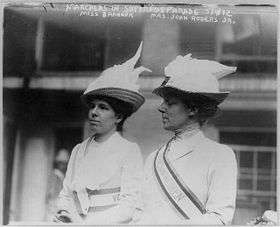Elizabeth Selden Rogers
| Elizabeth Selden Rogers | |
|---|---|
|
Elizabeth Selden Rogers, right, marches in a suffragette parade with Miss Brannan, left, ca. 1912. | |
| Born |
Elizabeth Selden White July 23, 1868 Astoria, Queens |
| Died |
December 18, 1950 (aged 82) New York City, New York |
| Spouse(s) | John Rogers (1865-1939) (m. 1895) |
| Children |
John Rogers, Jr. (1899-??), Charles White Rogers (1900-1903) Elizabeth Selden Rogers Horan (1907-1984) |
| Relatives |
Mabel Wellington White, sister Amos Beebe Eaton grandfather Roger Sherman, 2nd great grandfather |
Elizabeth Selden White Rogers (July 23, 1868 – December 18, 1950) was a civic reformer working to improve the New York public schools, and to win suffrage for women in the state of New York and the nation.
Early life and education
She was born on July 23, 1868, in Astoria, Queens, New York. Her sister was Mabel Wellington White, wife of US Secretary of War Henry L. Stimson, she was also the maternal granddaughter of Union Major General Amos Beebe Eaton and a descendant of Roger Sherman, one of the Founding Fathers of the United States.
Elizabeth Selden Rogers married John Rogers (1865-1939) in 1895. He was later at the Cornell Medical School.[1] They had a daughter, Elizabeth Selden Rogers, who married Francis H. Horan,[2] and two sons.
Career
She was chairman of the Advisory Council of the National Woman's Party and its Legislative Chairman for New York, and was one of the most forceful speakers in the "Prison Special" bus tour across the country; during which suffragists spoke of their experience in jail. Rogers was arrested, as part of the Silent Sentinels protest, on July 14, 1917 for picketing in front of the United States White House, and was sentenced to sixty days in Occoquan Workhouse in Virginia; but she was quickly pardoned by US President Woodrow Wilson after just three days. .[3]
Elizabeth Selden Rogers, editorial entitled "Why We Withdrew," in Women's Political World, 1915
A great deal is said of the value of co-operation of all societies and the economy of not duplicating work. While believing heartily in a certain amount and kind of co-operation, we are not blind to the fact that too complete unity may result. in stagnation ... The [Women's Political) Union believes that the existence of many suffrage societies is an evidence of the vitality of the movement, and that the friendly rivalry of such societies results in more and better work being done, that it gives the freedom necessary to growth, affording scope for individuality, and allowing personality to count. ... To those of our members who are worrying over this co-operate (sic) idea, we would point out that if in the past four or five years the Women's Political Union in New York City had been bound by a two-thirds vote of a campaign committee, like the one now formed, we would never have had a parade, or an outdoor meeting, or a campaign against certain enemies in the Legislature.
Personal life
Elizabeth Selden White Rogers died on December 18, 1950 in New York City.[4]
See also
References
- ↑ "Obituary". New York Times. November 21, 1939.
Rogers - On Sunday, November 19, [1939] at his home, John Rogers, M.D., in the seventy-fourth year of his age, beloved husband of Elizabeth Selden (White) Rogers. ...
- ↑ "Elizabeth S. Rogers Will be Bride Today. She and Fiance, Francis Horan, Are Members of United States Attorney's Office.". New York Times. February 9, 1935. Retrieved 2008-07-04.
Miss Elizabeth Selden Rogers, an assistant to Martin Conboy, United States Attorney of the Southern District of New York, and Francis H. Horan, ...
- ↑ Stevens, Doris (1920). "Jailed For Freedom". Boni and Liveright. Retrieved 2012-07-25., 367
- ↑ "Obituary". New York Times. December 18, 1950. Retrieved 2008-07-04.
Mrs. Elizabeth Selden White Rogers, a leader in the fight for woman suffrage, who was the widow of Dr. John Rogers, former Professor of Clinical ...
